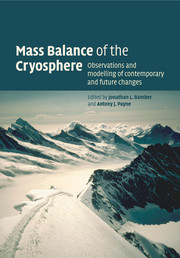Book contents
- Frontmatter
- Contents
- List of contributors
- Foreword
- Preface
- 1 Introduction and background
- Part I Observational techniques and methods
- Part II Modelling techniques and methods
- Part III The mass balance of sea ice
- 8 Sea-ice observations
- 9 Sea-ice modelling
- Part IV The mass balance of the ice sheets
- Part V The mass balance of ice caps and glaciers
- Index
- References
8 - Sea-ice observations
Published online by Cambridge University Press: 16 October 2009
- Frontmatter
- Contents
- List of contributors
- Foreword
- Preface
- 1 Introduction and background
- Part I Observational techniques and methods
- Part II Modelling techniques and methods
- Part III The mass balance of sea ice
- 8 Sea-ice observations
- 9 Sea-ice modelling
- Part IV The mass balance of the ice sheets
- Part V The mass balance of ice caps and glaciers
- Index
- References
Summary
Introduction
The Earth's climate system is presently undergoing an uncontrolled experiment as a result of man's increasing emissions of carbon dioxide (CO2), methane (CH4), nitrous oxide (N2O) and other greenhouse gases – gases that exert a positive radiative forcing of climate – into the atmosphere, as well as anthropogenic aerosols (microscopic particles) that have a negative radiative forcing. As a net result of these forcings and associated dynamics, changes in global mean temperature are predicted to exceed their natural variability between the decades 1980 and 2010 (Cubasch et al., 1995). An assessment by the Intergovernmental Panel on Climate Change (IPCC) concluded cautiously that the balance of observational evidence already suggests a discernible human influence on the global climate (IPCC, 1995).
As a complement to observational studies, numerical models are used to understand better climate and climate change, including the effect of anthropogenic emissions of greenhouse gases and aerosols. The most advanced climate models are coupled oceanic and atmospheric general circulation models (GCMs). These models simulate the climate system based on physical laws describing the dynamics and physics of the ocean and atmosphere, and include representations of land–surface processes and other complex processes including those related to sea ice. Model runs include changes in external forcings such as those from increasing greenhouse gases and aerosols. A consensus from the numerical modelling community is that greenhouse warming will be enhanced in the polar regions, especially the Arctic (Figure 8.1).
- Type
- Chapter
- Information
- Mass Balance of the CryosphereObservations and Modelling of Contemporary and Future Changes, pp. 337 - 366Publisher: Cambridge University PressPrint publication year: 2004
References
- 1
- Cited by



